
Visit Shrines
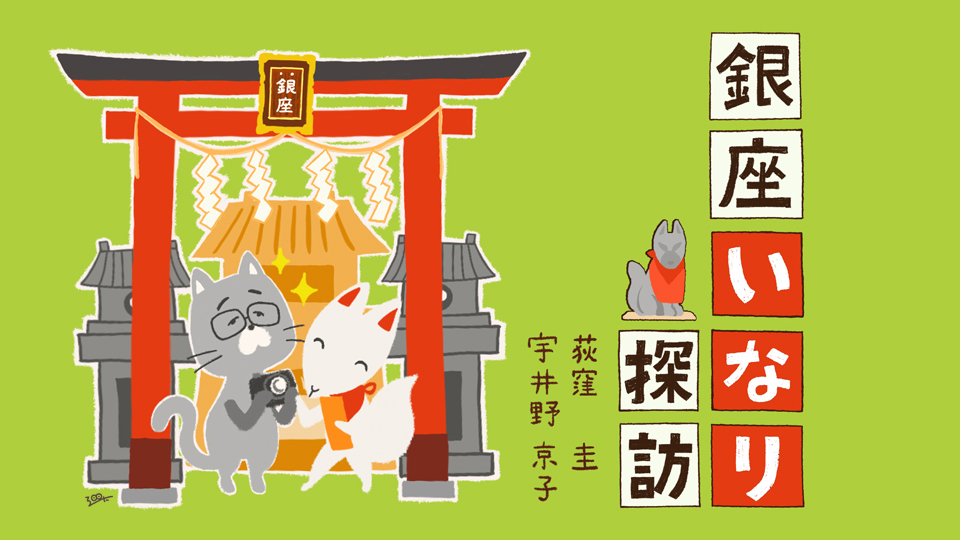
Visit Ginza’s Shrines Vol. 16 Hodo Inari Shrine
2023.11.01
Perhaps there is a flourishing neighborhood near you that has developed around a temple or a shrine. A place of prayer can bring people together and develop a community. Today we will introduce a small shrine that presents a vivid picture of that kind of history.
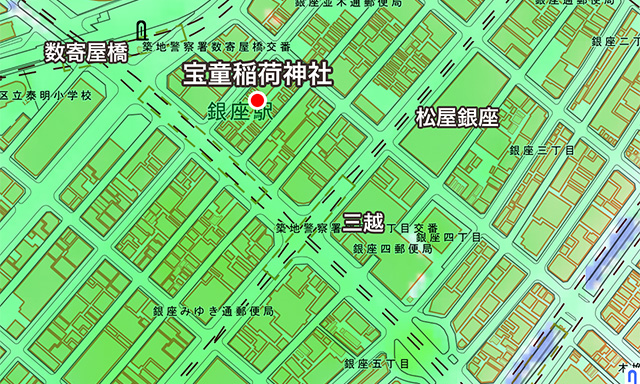
between Ginza Renga-dori and Namiki-dori.
-
Inari Shrine.
- Ogikubo
- Today’s meeting point is quite unique.
- Uino
- Yes. Today, I had you come to Gojuon, a store in front of the Hojo Inari Shrine’s gate.
Now, allow me re-introduce myself. I run this store and at the same time take care of Hodo Inari in Ginza 4-chome as its “moribito,” or guardian. My relationship with the Hoji Inari was part of how the “Visit Ginza Shrines” series began.
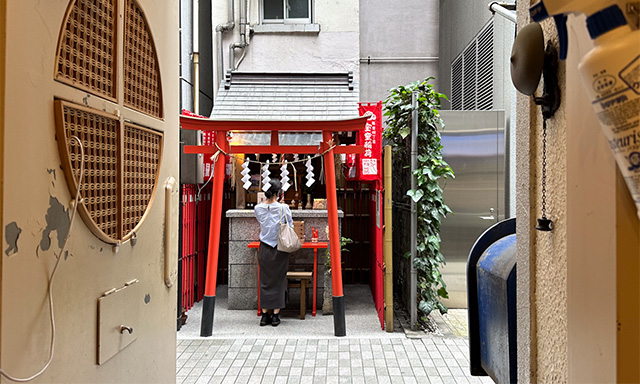
The store faces the Hodo Inari Shrine.
- Ogikubo
- Is that so? I believe it was before I met you that I once had the opportunity of coming to this area before the current pavilion was built. I wandered in curious about what I would find on this narrow street. Then I found this small store, Gojuon. Although I was very curious about what it sold, I did not have the courage to come in at the time (laughs). I took pictures wondering what the empty square space in the corner of the building in front was going to turn into. The next time I came, I was surprised to find a shrine there.
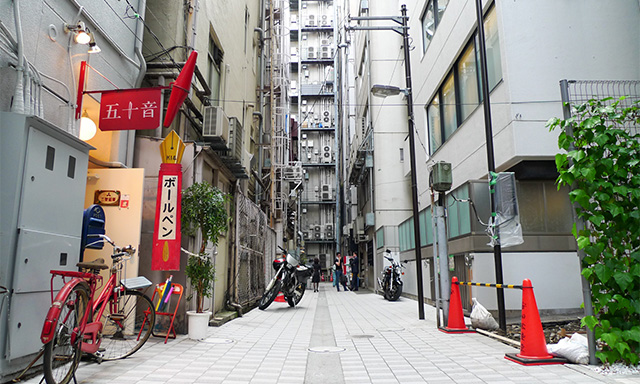
to the left stood Gojuon and to the right, a small open space under construction .
September 2008
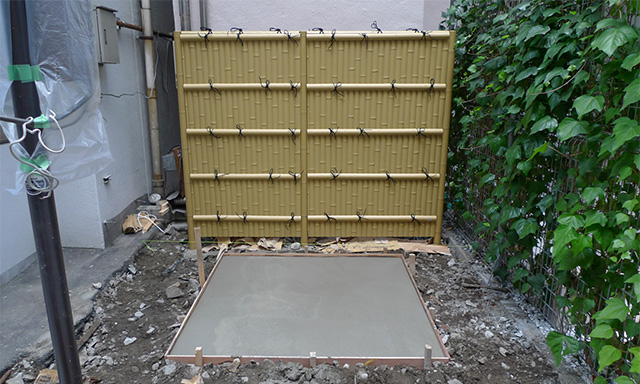
- Uino
- The reconstruction of the current pavilion began in November 2007 and the deity was moved to the new shrine on October 24, 2008.
- Ogikubo
- It has been well maintained and managed even amid the re-development of the area. A beautiful pavilion neatly kept with flower offerings, it looks like the shrine is being well taken care of unnoticed by tourists. But I had no idea that you were taking care of it.
- Uino
- Yes. It is a very interesting coincidence (laughs).
- Ogikubo
- When you started to look after the shrine, what did Hodo Inari Shrine look like?
- Uino
- I have a photo of the old shrine in my possession that I used in a book. We could walk up to the main pavilion by walking up three steps. However, the doors would be opened only during festivals, and it had a closed atmosphere. Now it is much more open and has a brighter atmosphere.
- Ogikubo
- Was it located in the same place where it sits now?
- Uino
- Yes, it was. I did find a record of it sitting in a different corner of the neighborhood before the Great Kanto Earthquake.
- Ogikubo
- So it was re-enshrined at its current location after the earthquake. Did the Inari Shrine exist from the Edo period?
- Uino
- Yes, Hodo Inari Shrine is said to be a branch shrine of the Inari Shrine of the Edo Palace. Back then, this area was called Yazaemon-cho. Some say that Yazaemon-san was a “soji-no-mono,” whose duty was to manage the palace gardens. That would explain how the deity of Hodo Inari Shrine could have been divided from the deity in the Edo Palace to be re-enshrined here. The Yaezaemon-cho district is said to have been established in 1628 (Kanei 5) to replace Yaesu Rogetsu-cho. Therefore, the Inari deity could have been divided from the Edo Palace around then, or perhaps earlier. Do you have any old maps that would tell the story?
- Ogikubo
- On the “Tsukiji Hacchobori Nihonbashi Minami Ezu” of the Edo Kiriezu, we can find a “Yazaemon-cho”. It seems to have stretched across both sides of Namiki-dori in Ginza 4-chome.
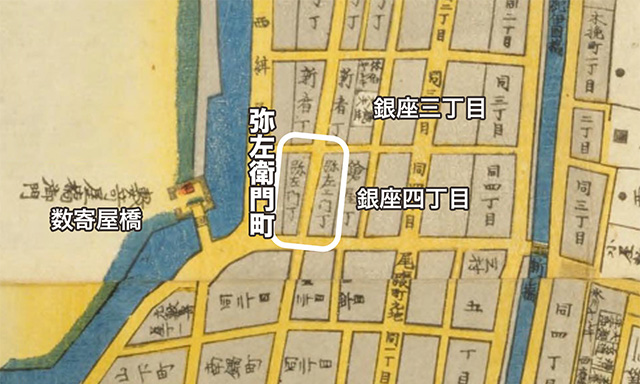
(Orwariya Kiyoshichi, National Diet Libirary digital collection)
- Ogikubo
- It is interesting how many districts were named after the developer during the Edo period. By the way, Hodo is not a very common word. What does it mean?
- Uino
- Actually, the details of the origin of Hodo Inari Shrine’s name are unknown. But the original Inari deity was worshiped with wishes for the Shogun’s successors to grow up in health at the palace. Therefore, that may be the origin of its name, which means treasuring children
- Ogikubo
- I cannot find any other Inari Shrines or shrines with the name Hodo. Let me search for temples… There is a temple named Hoboin Temple in Tokyo. “Hobo” stands for a flag decorated with gems, so it could also be imagined that this name eventually evolved into Hodo.
- Uino
- Yazaemon-cho was home to many publishing houses in the Meiji period and beyond. Kitamura Togoku is also known to have lived in the area. Perhaps it has always been an area for people with a good taste in literature and hence the Inari Shrine was given its beautiful name.
- Ogikubo
- So, to summarize, the story goes that when Yazaemon-san became “nanushi” (administrator) of Yazaemon-cho, he invited the Inari deity from the Edo Palace to be divided and re-enshrined there, and now the shrine is guardian of Ginza 4-chome.
- Uino
- Ginza’s districts are divided into smaller areas, so to be precise, it guards the area around Namiki-dori in Ginza 4-chome. There is another reason for Hodo Inari Shrine’s close relationship with former Yazaemon-cho.
- Ogikubo
- I am curious.
- Uino
- The Inari Shrine is currently managed by the district association, which started as a group of local people who came together for the purpose of reconstructing the Inari Shrine which had been burnt down, and later evolved into a community organization.
- Ogikubo
- I see. It was an attempt to restore the town along with the shrine.
- Uino
- Yes, but the Hodo Inari Shrine is worshipped not only by the local people but also by people from all over Japan. This flag is evidence.
- Ogikubo
- What kind of flag is it?
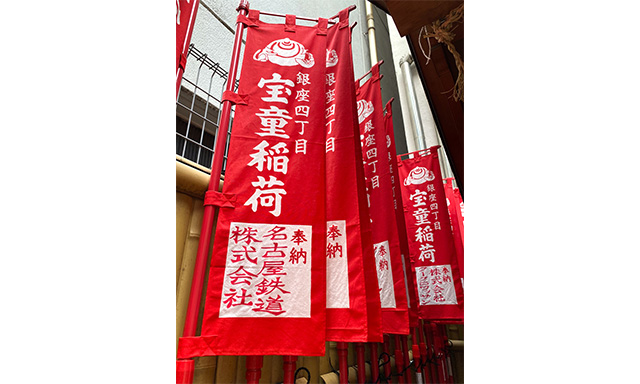
- Uino
- The flags are replaced once every year. Since this is a small Inari Shrine, the flags come in a mini size made by special order. The dedicators’ names are handwritten in vermillion to match the flag color. They write on the backside as well, so it looks like a work of shape-resist dyeing People from distant places make donations as well.
- Ogikubo
- I see. The bright atmosphere that I feel every time I come to visit may be because of the bright flags. And it is also good that although the shrine is located in a backstreet, there is a small guiding post on Ginza Renga-dori pointing to the shrine. I wonder why it is a chimpanzee, though…
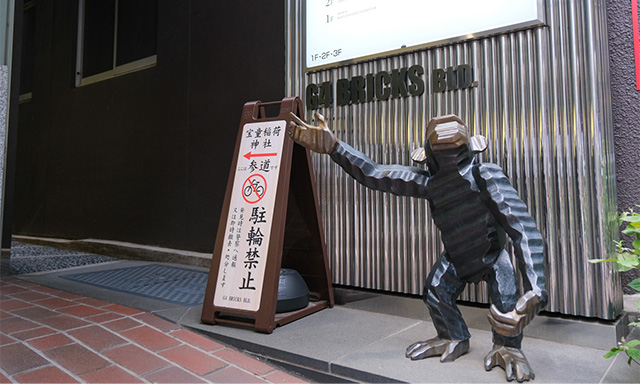
to walk through a narrow street between buildings to visit the shrine.
- Uino
- This is a street art installation by the building. Therefore, it has no direct relationship with the Inari Shrine. The building owner has offered private land to be used as the approach to the shrine and the bronze statue was ordered to stand in a posture that pointed to the Inari shrine. Along with the angel at Teshodo, this is a popular photogenic spot in the area. Yet, since the approach itself is difficult to find, I am often told by visitors that they wished it had a one thousand torii gate approach. I hope the local district organization can make it happen someday out of their love for the Inari Shrine and for the elegance of Ginza.
- Ogikubo
- We have visited a diversity of Inari Shrines in Ginza and each of them had a unique way of preservation. Sometimes we would go up to the roof and other time,s we would go through narrow streets. Some shrines were portable. It is wonderful that land has been secured for Hodo Inari Shrine and that it even has an approach.
- Uino
- Yes, it is the result of the challenges overcome by our forerunners and the collective efforts of people who run businesses here in Ginza, people who work here, and people who live here, although that number has been on the decrease. The way that a district association is protecting the Inari Shrine from the troubled waters of contemporary times and the Inari Shrine has the power to bring such an association together to protect it shows a modern way of keeping a local Inari Shrine. As a guardian, I am determined to make every effort to make it a pleasant destination for visitors
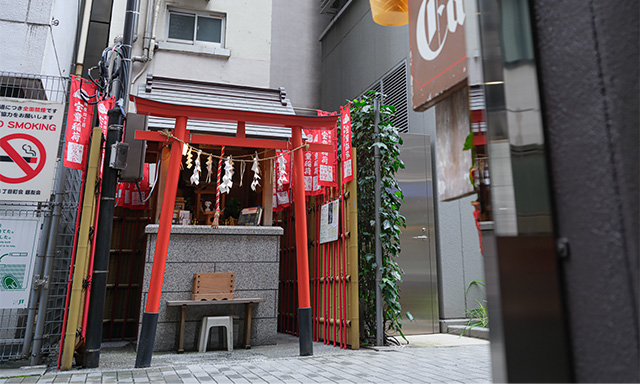
The red torii gate and small flags mark the spot.
All List
- 2020.05.01 Visit Ginza’s Inari Shrines Vol.2 Asahi Inari Shrine
- 2020.08.01 Vol.3 Exploring Ginza in the Edo Period on an old map
- 2020.11.01 Visit Ginza’s Inari Shrines Vol. 4 Kakugo Inari Shrine
- 2021.02.01 Visit Ginza’s Inari Shrines Vol. 5 Azuma Inari
- 2021.05.01 Visit Ginza’s Inari Shrines Vol.6 Kabuki Inari
- 2021.08.01 Visit Ginza’s Inari Shrines Vol.7 Ginza Inari in Ginza 2-chome
- 2021.11.01 Visiting Ginza’s Shrines Vol. 8 Kumagai Inari Shrine
- 2022.02.01 Visit Ginza Shrines Vol. 9 Saiwai Inari Shrine
- 2022.05.01 Visit Ginza’s Shrine Vol. 10 Mimeguri Shrine and Shusse Jizoson on the roof of Mitsukoshi Department Store
- 2022.08.01 Visit Ginza’s Shrines Vol. 11 Komparu Inari
- 2022.11.01 Visit Ginza’s Inari Shrines Vol.12 Mankin Ryujin Seiko Inari Shrine
- 2023.02.01 Visit Ginza’s Shrines Vol.13 Hachikan Shrine
- 2023.05.01 Visit Ginza’s Inari Shrines Vol.14 Hoju Inari Shrine
- 2023.08.01 Visit Ginza’ Inari Shrines Vol. 15 Ryuko Fudo-son
- 2023.11.01 Visit Ginza’s Shrines Vol. 16 Hodo Inari Shrine
- 2024.02.01 Visit Ginza’s Shrines Vol. 17 Toyoiwa Inari Shrine
- 2024.05.01 Visit Ginza’s Inari Shrines Vol. 18 Yasuhira Shrine
- 2024.08.01 Visit Ginza’s Inari Shrines: Final Edition








